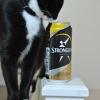It's not so much the handling, which is the way the car responds to inputs of steering braking and power application, it is the accuracy and more precise 'feel' of the car on the road, ..engineers at Austin-Rover made changes in various areas which didn't improve the car at all ... mounting failures and some odd loading on the structure
They did other stupid things too such as mixing imperial and metric threads ..
the early cars with solid mounted front sub-frames, 3.5" wheels and narrow tyres were the very best.
Tell me about imperial and metric threads B-( ( as a matter of fact i did measure some bolts and I think they even had imperial size 6 faced heads on bolts with metric diametre and threading ...
the 3.5" wheels I have them in my garage , but I have to disagree with you on the fact that they are better : the 5"wide wheels and tyres are much better with good tyres (compound wise) they have more lateral resistance then the narrow tyres and the modern compounds allow for less roll-resistance while allowing more water to be evacuated from underneath the tyre in rainy conditions,
Actually afa the inverse rubbermount -> solidmount is concerned it does indicate a positive influence, the wear of rubbermounts does seem to indicate there is enough change in the pressure to influence handling and eventually suspension and geometry ... and that is soemthin I didn't expect
I believe you are not defining between 'road-holding' and 'handling.They are completely different. To define them:
Road-holding is the direct measurement of centripetal force which can be generated when driving in a constant radius circle on a given surface. This is dependent on the tyre size & compound, the suspension settings, the roll resistance, the road surface and some other less critical factors.
Handling is the way the car responds to the steering, braking and power application. It is more subjective and depends on different factors.
For example, a rally car with forest tyres will have very poor road-holding on a firm tarmac surface, but with its compliant suspension and well-set-up suspension settings it will be a much better handling car than a race car with huge wide slick tyres, low C of G and a rear anti-roll bar.
With 3.5" wheels and the narrow tyres the handling is fantastic. The way in which such a car responds to the steering input and the predictably when braking are about the ideal. Of course a car with better and softer tyres will stop better in the wet (and probably in the dry), it will achieve a higher cornering force, but it will not 'handle' as well. The finest handling car I think I've ever tested was a Mk.1 Escort Twin-Cam with forest tyres. The road-holding was not good, but it would hold a sideways stance through a long corner with power on and a small amount of negative (opposite) lock with ease and it gave the driver great confidence. Now that is handling.
One of the worst handling cars I've driven was a Porsche 911 Carrera on full racing tyres. The road-holding was incredible, but it felt unpredictable and that it would 'bite me in the bum' if I got it wrong. It turned out that it had the wrong rear anti-roll bar, one for forest rallying, and once changed it was super in both areas.
With regard to the metric threads, the wonderful ARG engineers, in order to save money, decided to fit the front/rear pressure valve (the one on the bulkhead) with a unit having 10 mm fine metric threads. However, the other ends of those pipes have 3/8" UNF threads and it is possible to fit them the wrong way around (with a bit of 'graunching') and have a system which leaks brake fluid. This on a safety critical system. You couldn't make it up. It is typical of the reasons why Rover went under - sheer incompetence!

















